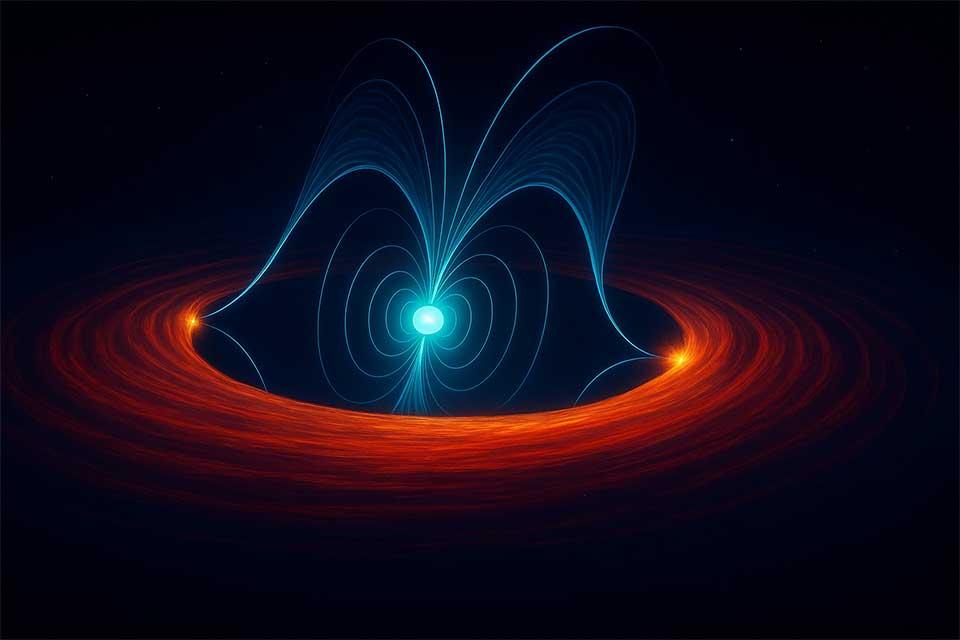Physicists from the University of Oxford have been part of an international team who have uncovered new insights into the behaviour of a rare transitional millisecond pulsar. The target, PSR J1023, is one of only a handful of known “transitional” pulsars – systems that switch between two dramatically different states: a quiet, radio-loud mode and a highly active, accreting state where material from a companion star is pulled in, producing variable emission across the electromagnetic spectrum. The findings were made thanks to coordinated observations across radio, optical, and x-ray wavelengths and are presented in two papers published in The Astrophysical Journal Letters and Astronomy & Astrophysics.
Dr Andrew Hughes and Dr Francesco Carotenuto from the Department of Physics at Oxford were part of the study which presents results from a large-scale multi-wavelength polarimetric campaign. Observations were made with NASA’s Imaging X-ray Polarimetry Explorer (IXPE), the European Southern Observatory’s Very Large Telescope (VLT), and the Karl G. Jansky Very Large Array (VLA). The research was led by Dr Maria Cristina Baglio of INAF-Brera Observatory in Italy.
At X-ray and optical wavelengths, the team detected striking polarisation signals that shed new light on the emission mechanism. IXPE measured a remarkably high X-ray polarisation of around 12%, while VLT observations revealed an optical polarisation of about 1%. The most significant finding is the alignment of the polarisation angles across both bands – despite their very different wavelength – indicating a shared origin. This combination of a large X-ray polarisation fraction and consistent orientation strongly supports a scenario in which the emission does not arise from hot spots or surface interactions on the neutron star, as is common in many systems. Instead, in transitional millisecond pulsars, the emission likely originates from synchrotron radiation produced by particles accelerated at the boundary where the pulsar wind collides with the inner edge of the accretion disk.
‘Transitional millisecond pulsars are natural laboratories for studying how neutron stars evolve in binary systems,’ said Dr Maria Cristina Baglio. ‘Our observations of PSR J1023 reveal a remarkably consistent polarisation orientation spanning from optical light to x-rays. The alignment of polarisation angles across these bands strongly suggests a single, coherent physical process driving the pulsar’s broadband [optical-to-X-ray] emission.’
Radio observations, which trace lower-energy emission, told a completely different story. Led by the Oxford team, the analysis of data from the VLA revealed no detectable polarisation in the system’s radio emission. Far from being a null result, this absence helped further constrain the geometry of PSR J1023 and pointed to the presence of a second energetic interaction region. ‘The lack of radio polarisation in our data provides a strong clue,’ said Dr Andrew Hughes. ‘It supports the idea that, while the X-ray and optical emission originates from colliding winds near the pulsar, the radio emission arises from a separate, jetted outflow of relativistic particles - indicating that the system hosts not one, but two distinct high-energy particle acceleration zone’
These multi-wavelength observations provide an unprecedented view of the complex interplay between accretion, magnetic fields, and high-energy outflows. ‘Our study highlights the critical role of coordinated, multi-band campaigns – especially those incorporating sensitive radio data – in unlocking the physics of these exotic stellar remnants,’ adds Dr Carotenuto. ‘While PSR J1023 is the canonical transitional millisecond pulsar, a couple of other systems also fall into this class, with a few more considered candidates. Further observations of this broader population are both possible and likely essential for determining whether the geometry observed in PSR J1023 is representative of transitional millisecond pulsars more generally; or if it is a unique source among unique sources.’
1 Polarised multiwavelength emission from pulsar wind - accretion disk interaction in a transitional millisecond pulsar, M Baglio et al, The Astrophysical Journal Letters, 1 July 2025
2 IXPE About: Expanding the x-ray View of the Universe
3 https://doi.org/10.1051/0004-6361/202453468

